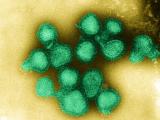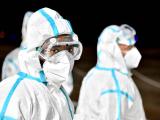Jun 9, 2010 (CIDRAP News) – When the H1N1 pandemic influenza began hitting Singapore's military forces last summer, health officials largely arrested its spread by giving oseltamivir to everyone in the affected units, in combination with other preventive steps, according to a report released today.
Among 1,175 soldiers in four settings, 75 were infected before the preventive steps were taken, and only seven became infected afterward, according to the report in the New England Journal of Medicine (NEJM). The findings suggest that antiviral "ring prophylaxis," along with quick identification and isolation of infected people, can be effective in halting outbreaks in "semiclosed" settings, the researchers said.
In a second study, also released today by NEJM, Hong Kong researchers looked at flu in a modest-sized sample of households and found that pandemic H1N1 and seasonal flu viruses spread at about the same rate and caused illnesses of similar severity.
Antiviral prophylaxis in Singapore
When pandemic flu cases first cropped up in the Singapore Armed Forces in June 2009, health officials determined to combat the virus by testing suspected case-patients, isolating those who tested positive, segregating affected military units, and administering oseltamivir to everyone in those units, according to the NEJM report by Vernon J. Lee, MB, BS, MPH, and colleagues.
Authorities decided to give antivirals to everyone in the affected units because of the difficulty of quickly identifying close contacts of infected personnel, the report says. The prophylactic regimen consisted of 75 mg of oseltamivir daily for 10 days.
The report describes the effects of the preventive strategy in four settings, including three military units of varying sizes and one camp medical center. The settings were described as semiclosed because, in Singapore's universal military service system, most personnel live in barracks on weekdays but return home on weekends.
Overall, the proportion of infected personnel was 6.4% (75 of 1,175) before the interventions; afterward this dropped to 0.6% (7 of 1,175). The researchers calculated that the reproductive number for the outbreaks was 1.91 (95% credible interval, 1.50 to 2.36) before the interventions and declined to 0.11 (95% credible interval, 0.05 to 0.20) afterward.
The report says ring prophylaxis was associated with significant reductions in cases in three of the four outbreaks. One outbreak included eight cases among 216 personnel before the intervention and three afterward, which did not achieve significance.
"We have shown that ring prophylaxis with oseltamvir given after exposure in military camps, including a health care setting, was effective, allowing training and operations to continue while substantially reducing the risk of further generations of cases during prophylaxis," the investigators state.
They add, however, that the use of oseltamivir for containment "may be limited to semiclosed or closed communities, since transmission in communities in the general population may subsequently lead to further outbreaks."
Household transmission scrutinized
In the Hong Kong study, researchers recruited 348 patients with respiratory illness from 14 outpatient clinics in July and August of 2009. They ended up with 99 patients with confirmed flu, including 45 with pandemic H1N1, 49 with seasonal H3N2, and 5 with seasonal H1N1.
The investigators prospectively followed 284 household contacts of the patients for a week, testing them for flu three times in that period and instructing them to record symptoms and take their own temperatures. The contacts were given hand-hygiene instructions along with hand soap and an alcohol hand rub.
As confirmed by polymerase chain reaction testing, the overall secondary attack rate in the household contacts was 8% (95% confidence interval [CI], 3 to 14) for the pandemic virus and 9% (95% CI, 5 to 15) for the seasonal viruses. However, the results for attack rates of influenza-like illness differed somewhat: 6% among contacts of pandemic flu patients versus 4% for contacts of seasonal flu patients.
Patterns of viral shedding and the course of illness also were similar for the pandemic and seasonal viruses. For both types, viral shedding ended after 5 to 7 days of illness and respiratory symptoms lasted up to 10 days.
The researchers tested baseline and convalescent serum samples from a subgroup of index patients and contacts who had confirmed pandemic or seasonal flu infections. In this subgroup, 36% of the household contacts who had serologic evidence of pandemic flu infection reported no symptoms and did not shed the virus.
Oseltamivir was prescribed for 44% of the patients who had positive rapid test results in the study. The serologic findings suggested that pandemic flu patients treated with oseltamivir may have lower levels of antibodies during the convalescent phase as compared with untreated patients, the report says. This indicates that H1N1 patients treated with antivirals could be at risk for reinfection later, a possibility that warrants further study, the authors say.
"Our study suggests that pandemic and seasonal influenza A viruses are associated with similar viral-load dynamics, severity of clinical illness, and transmissibility," the report concludes.
In an accompanying NEJM editorial, Timothy M. Uyeki, MD, MPH, of the Centers for Disease Control and Prevention writes that the two studies, along with others, suggest that interventions used to control seasonal flu in institutions should also work for the pandemic virus. These measures work best when outbreaks are identified early and the responses are carried out quickly, he adds.
Uyeki comments that the Singapore findings, since they stem from semiclosed settings, "do not directly inform the success of potential containment efforts implemented at the source of the next influenza pandemic or implemented to prevent the introduction of influenza into a community."
Lee VJ, Yap J, Cook AR, et al. Oseltamivir ring prophylaxis for containment of 2009 H1N1 influenza outbreaks. N Engl J Med 2010 Jun 10;362(23):2166-74 [Full text]
Cowling BJ, Chan KH, Fang VJ, et al. Comparative epidemiology of pandemic and seasonal influenza A in households. N Engl J Med 2010 Jun 10;362(23):2175-84 [Full text]
Uyeki TM. 2009 H1N1 virus transmission and outbreaks. (Editorial) N Engl J Med 2010 Jun 10;362(23):2221-23 [Full text]




















